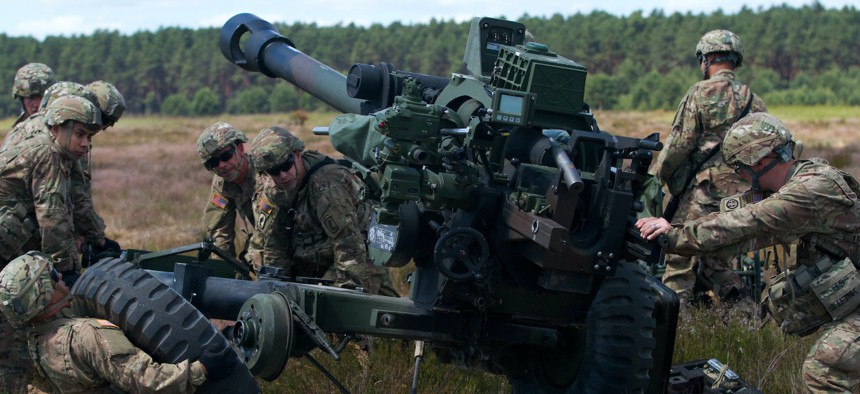
In this 2015 photo, U.S. Army soldiers assemble a M119 105mm Towed Howitzer. U.S. Army / Spc. Marcus Floyd
The future is ‘not bright’ for towed artillery, Army general says
Light infantry units also need more indirect fire systems, Gen. Rainey said.
HUNTSVILLE, Alabama—The Army’s towed howitzers, many of which have been sent to Ukraine, are becoming increasingly obsolete, U.S. Army Futures Command head Gen. James Rainey said Wednesday.
“I personally believe that we have witnessed the end of the effectiveness of towed artillery,” Rainey said here at the AUSA Global Force conference. “The future is not bright for towed artillery.”
The Army operates towed artillery, which is carted to firing positions by Army vehicles, and self-propelled artillery, which can maneuver to positions on its own.
Future artillery systems must “continuously move,” with “no displacement” time, Rainey said, referring to the time it takes a gun-crew to move a cannon from its firing position.
Light infantry units, such as Stryker brigades, could also benefit from mobile indirect fire systems, he said. Indirect fire systems are a military category that includes everything from artillery to rockets like the Guided Multiple Launch Rocket System.
Rainey also expressed interest in what he referred to as an autonomous and robotic cannon for joint forcible entry operations, the name the Army gives to operations like taking and securing beachheads or runways.
Rainey’s comments come on the heels of an Army study on the force’s future artillery needs. The evaluation, dubbed the tactical fires study, was reportedly set to be completed ahead of the fiscal 2025 budget submission made this month, but the results have not been released.
The Army stopped funding the Extended Range Cannon Artillery (ERCA) in the 2025 proposed budget. The new cannon was meant to lob rounds as far as 70 kilometers, or more than double the 30 kilometer range for the Army’s standard M109 Paladin howitzer.
But the service will continue to invest in long range systems, and is now looking at domestic and international artillery manufacturers to meet the Army’s long-range needs, army acquisition chief Doug Bush said in a March 8 briefing on the Army’s budget submission.
“The fires study validated the range and volume are still needed, so we want to find a different way to get there,” Bush said. The Army is also continuing development of modified artillery rounds that were developed for the program.
The service previously tested ERCA-fired rounds that hit targets over 68 miles away. Another version of the round, announced in October of last year, was fired from the Paladin howitzer and reportedly flew farther than any previous projectile shot by a Paladin, although officials did not give a specific range.
The Army is working on the new options amid reports that Russia has had success quickly targeting Ukrainian equipment with the help of surveillance systems like drones.
Some Russian artillery crews that operate their own drones can strike targets within 180 seconds of detecting them, according to a study by the Royal United Services Institute. Crews that reported their targets to a fire-control center might expect to hit those targets within 30 minutes of spotting them.
In what may be a sign of an increasingly sophisticated targeting process, Russia struck multiple high-value Western-donated weapons that had rarely or never been hit before. Systems destroyed by Russia included Patriot anti-air missile launchers, a National Advanced Surface-to-Air Missile System, and a High-Mobility Artillery Rocket System.




